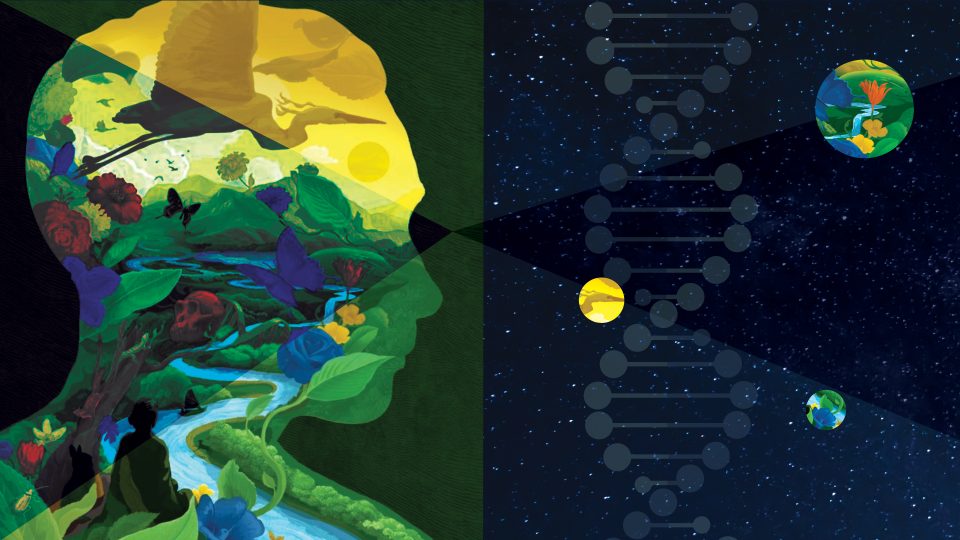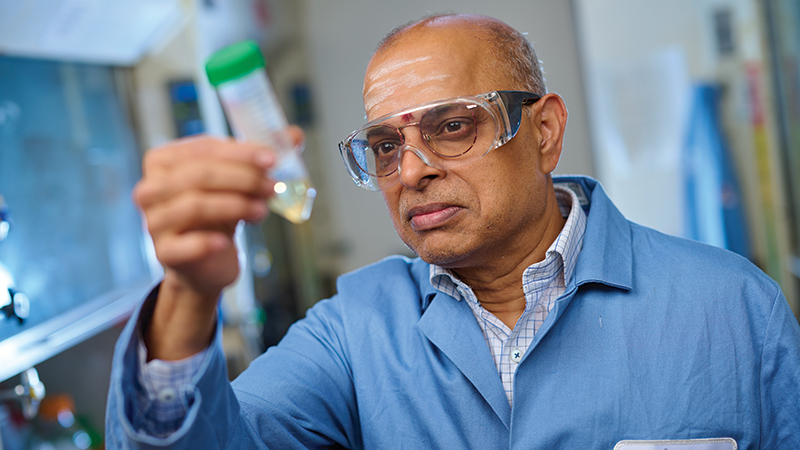
Four and a half billion years ago, a swirling cloud of gas and dust settled into a dense, rocky planet. Over the next few hundred million years, molecules on this lifeless, watery mass—Earth—came together in new ways. Some of these chemical reactions generated the precursors to life as we know it today. Over time, simple single-celled organisms evolved into microbes, plants, fish, dinosaurs and, eventually, humans.
For the past three decades, Scripps Research professor Ramanarayanan Krishnamurthy has been studying the chemical reactions that may have led to life billions of years ago. In a test tube, he has demonstrated how molecules present on the early Earth can form the precursors to living cells.
Scripps Research Magazine sat down to talk with Krishnamurthy about his path to science, how his research could help NASA find life on other planets, and how he balances philosophy and science.

What first inspired you to become a scientist?
I was born in India, in a port city called Chennai. My family was quite religious, and in the Hindu philosophy there was always this push to ask questions. So, I began thinking like a scientist in this philosophical way when I was quite young. I gravitated toward chemistry and remember explaining to my siblings how everything we do is related to chemistry—laughing, crying, eating. I used to sleep with chemistry textbooks beneath my pillow in the hopes that the knowledge would seep into my brain.
At the same time, Carl Sagan’s Cosmos aired on Sunday afternoons in India. My siblings and I would all finish our lunch, rush to the TV, and go on this wonderful journey in his imaginary spaceship. Cosmos got me interested in the origin of life and questions about why things are the way they are.
What led you to apply your chemistry expertise to questions about the origins of life?
As an undergraduate at University of Madras, I studied organic chemistry, and then I worked as a synthetic organic chemist and received my master’s degree from IIT Bombay. In 1991, while a chemistry graduate student at Ohio State University, I attended a life-changing lecture by Albert Eschenmoser. His lecture beautifully outlined how chemistry could be used to explain why nature chose ribose, and not any number of other sugars, to be the backbone of RNA and DNA. Sitting there at this lecture was the first time I understood what it meant to fall in love with something. For weeks afterward, I could think of nothing except this idea that chemistry could be a tool to answer these deep philosophical questions about why things are the way they are.
I wrote to Eschenmoser and asked him whether I could do a postdoctoral fellowship with him. Back then, there was no email, and so it took six months of patient waiting to get snail mail with his response— that yes, he would let me study at the ETH in Zürich with him.
I spent two and a half years with Eschenmoser making alternative forms of DNA and RNA with different sugars as their backbones and studying their properties. In 1996, Eschenmoser and I started a lab jointly at Scripps Research to study questions about the structure of RNA and DNA from an origins-of-life perspective. We went on to demonstrate that, although sugars other than ribose might be able to make bases that formed tighter bonds, they wouldn’t have allowed the same ability for RNA and DNA to evolve because the resulting molecules would have been so incredibly stable and hard to change. It was a great illustration of the Goldilocks Principle: it is often not the extremes that have the evolutionary advantage. That principle has come up again and again in my work, and is often used when talking about whether planets could harbor life— they need to be not too cold, not too hot, but just right.
What does your lab focus on now?
I’m still fascinated by this question of what sort of chemistry can give rise to an entity that exhibits life-like properties. The approach that my lab takes to answering this question is to look at molecules that might have existed on early Earth and then figure out if there are pathways that naturally emerge when these molecules are mixed. Recently, my lab has shown how cyanide can enable the chemical reactions that turn prebiotic molecules and water into the basic organic compounds required for life, including amino acids that are the building blocks of proteins.
I’ve become involved in a NASA research coordination network that looks at prebiotic chemistry and the early Earth environment. It brings together researchers who think about the environmental constraints of the early Earth and researchers like me who study the types of chemistry that could have gone on considering those constraints.
Does this work have implications beyond studying how life in our universe began?
This field is a rather slow-moving one, which doesn’t always produce tools that have immediate utility. But some of the chemistry that we’re developing right now is leading toward techniques that could be useful for biochemists as well as NASA for future space missions. What we’re doing is thinking about ways to detect chemistry that are based on interactions between phosphorus and nitrogen rather than phosphorus and oxygen. In the lab, this is useful for detecting whether certain reactions have occurred. But it also becomes interesting in the context of NASA trying to spot signs of life or places where life could be possible.
Will we ever really know how life began?
We won’t ever be able to prove that we know the exact historical path of how life originated on Earth. The question will always be, ‘Yes, that’s possible, but did it happen that way four and a half billion years ago?’ So, I like to worry less about whether it did happen a particular way, and more about whether it can be demonstrated, and what that tells us about the possibility of life elsewhere.
What do you spend time on when you’re not at work?
One of my passions is philosophy; I really like to compare different philosophical approaches, and I think it keeps me grounded when I do research. I also do a lot of volunteer work within the local Indian community to help teach the next generation of Indian-Americans about our culture, our philosophy, and the demands of trying to balance assimilation with preserving our culture. Finally, I devote time to meditation, which is something I’ve been practicing since a young age. The funny thing is that when I find something very scientifically and intellectually satisfying, like discovering a new reaction, it actually reinforces that feeling that I get from meditation. So, I don’t see science and meditation as two different or parallel things; I actually see them as intertwined.